
 Swedish Navy – HSwMS Oden, Thor, Niord 1894-1937
Swedish Navy – HSwMS Oden, Thor, Niord 1894-1937
The Oden class was a class of armored ships in the Swedish navy. The class consisted of three ships; Odin, Thor and Niord. Their main armament consisted of two 25.4 cm guns in two single turrets, one in the bow and one in the stern, and the secondary armament consisted of six (on Oden four) 12 cm guns in casemates amidships. Oden was the first ship of the class and was launched on 9 March 1896, followed by Thor on 7 March 1897 and Niord on 30 March 1898. During the First World War, an extensive refit was carried out when, among other things, new boilers were installed and the chimneys were built together. The ships were decommissioned in the years 1937-39. Oden and Thor were scrapped in Karlskrona in 1944, while Niord was used for a time as a target ship before she was scrapped in 1945. #pansarkepp #pansarbåt #swedishnavy #svenskamarinen #WW1
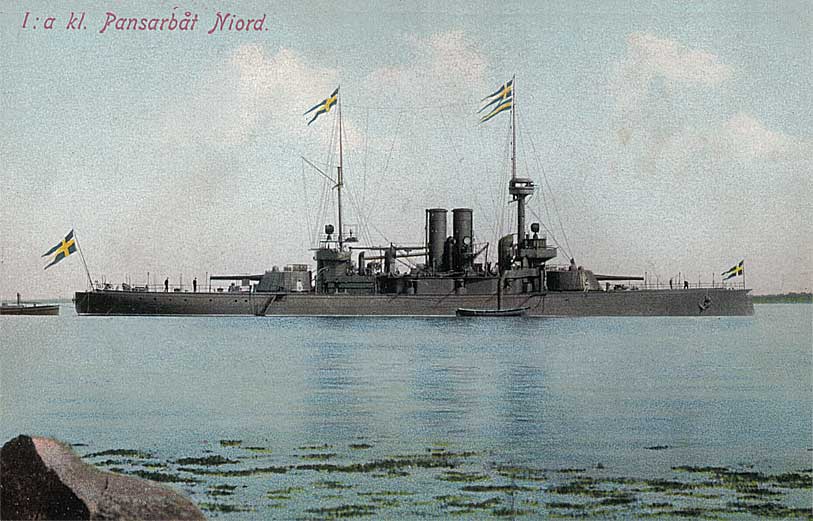
Design of the class
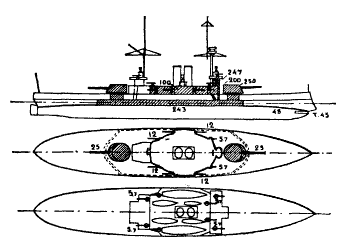 In the early 1880s, the Swedish navy assessed its weaknesses, which lasted for several decades. Great powers pat the time were now filling their ranks with large ocean-going battleships (pre-dreanought still) with heavy artillery. One of these was the newly created Kaiserliches Marine, a direct neighbour of the Baltic as well as Imperial Russia.
In the early 1880s, the Swedish navy assessed its weaknesses, which lasted for several decades. Great powers pat the time were now filling their ranks with large ocean-going battleships (pre-dreanought still) with heavy artillery. One of these was the newly created Kaiserliches Marine, a direct neighbour of the Baltic as well as Imperial Russia.
But these ships were expensive, and their great draft made them ill-suited for shallow Swedish waters. Still, heavy artillery ships were very useful as a deterrent, and mixed with armour, they were well adapted to Swedish conditions, leading to the development of Svea, launched in 1885. This coastal battleship was not unlike the previous Swedish sea-going monitors, but had a freeboard almost twice as large to better cope with heavy weather in the baltic, and she was more bulkier than previous Swedish armored ships (Pansarbat), in order to operate both at sea and in coastal waters.
At the time she featured two 25 cm guns in a single twin turret forward, and despite her relatively limited displacement (3,200 tons) her firepower that could scare any contemporary British battleship. Two other ships of the same class were ordered, Göta and Thule, launched 1889 and 1893. The navy thus had for the first time in almost 30 years a strong core ocean-going armoured warships core, able to meet a fleet beyond its own coastline, unlike previous monitors and gunboats.
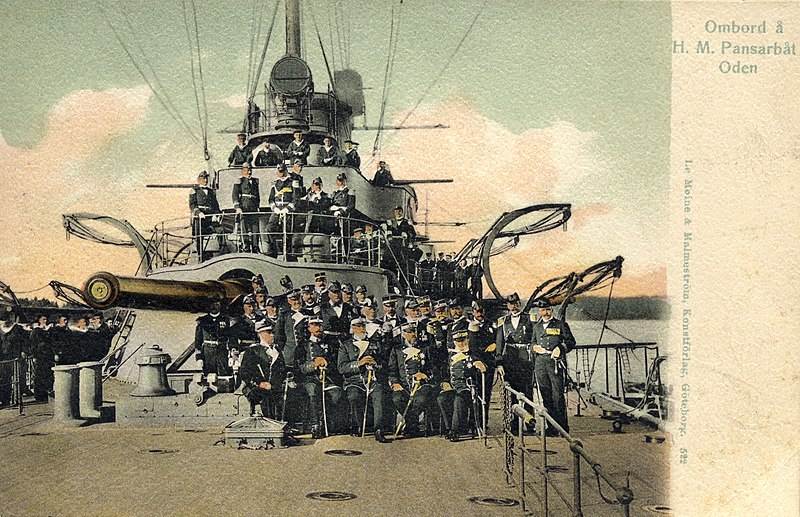
In 1892, a naval committee was appointed under ship designer Göthe Wilhelm Svenson, to study a new type of pansarbat, essentially an improved version of the previous design. The committee proposed still a true departure from the Svea class, with the heavy artillery now placed into two single turrets instead of a single twin (notably to reduce the chance of loosing it all in single lucky hit) and medium artillery artillery with rapid-fire guns, down to 12 cm (4.7-in) instead 15 cm (6-in). The new design was thus submitted to Riksdag (Swedish Parliament) which granted funds FY1894 and FY1895. It was also agreed that to continue with the tradition started earlier, the lead ship would be named Oden (Odin).
However, the geopolitical situation in the Baltic Sea, mainly the arms race between Russia and Germany, raised concern in Sweden. In 1895-1901, Germany strengthened its navy considerably, going from a few coastal battleships, to a brand new pre-dreanought class of battleships, the Kaiser Friedrich III class. They had four 24 cm, eighteen 15 cm guns, and could disposed of the Svea and Odin class with ease in case of a Swedish-German war. The Riksdag accepted to fund two sister ships to Oden in 1896, named Thor and Niord.
Oden was laid down in 1894 at the Bergsund At Finnboda shipyard, launched in 1896, to be commissioned in 1898. Niord was laid down in 1900 at Lindholmen Goteborg shipyard, launched in 1898, commissioned in 1899. Thor was laid down in 1896 at Bergsund, Finnboda shipyard, launched in 1898, commissioned in 1899. They were no longer the most powerful ships in the Baltic but at least were the best Scandinavia could offer.
Hull and general design
No blueprints yet
Their standard displacement was 3,500 tons, and when fully loaded, 3,715 tons. Thor and Niord were slightly lighter at 3,328 tons and 3,720 tons respectively. This was far more than the Svea class though. The hulls like before were made in riveted steel, with similar dimensions for all three sister ships. It was roughly similar to the Svea class but slightly larger, longer in order to carry two main turrets fore and aft. Oden thus measured 84.78 meters long at the waterline for 14.62 meters wide overall and with the same low draft of 5.1 meters. She lacked portholes unlike her sisters, being dependent of electrical lighting alone. She also had a ram bow and reinforced frames close to it, a weapon that proved its value at Lissa in 1866. The hull had a gradual beam with no straight section, and was roughly symetrical with the largest frame placed amidship. The stern was rounded. There was a tall rectangular rudder, and two propeller shafts.
To increase buoyancy, the hull was divided into approximately 200 watertight cells. The underwater hull had a cut-out keel, raised for and aft to increase agility.
Protection
By international standards, the Oden class were given a good level of armor protection. There was a thicker nickel steel armor supplied by French company Schneider & Co in Le Creusot, and a thinner one manufactured at home, by Bofors-Gullspång. Creusor steel protected the gun turrets and well as the conning turrets and waterline. The Bofors steel was placed around the casemate and sloped armored deck.
-The waterline belt stand 1.48 meters tall, over 50 meter between barbettes for the main guns, 24.3 cm in thickness, so to resist at least 25 cm shells.
-The main gun barbettes had 24.7 cm armor plate. It went down to the armour deck.
-The turrets had 20 cm walls all around plus 30 mm roofs.
-The 12 cm guns casemated shields and the casemate walls had 10 cm in thickness.
-The forward conning tower had 24.7 cm armor.
-The armoured deck was 49 mm thick, connected by its lower end slopes, turtleback outside citadel.
-Armored bulkheads of the same thickness closed it into a citadel, above machinery spaces and ammunition rooms.
Thor and Niord differed from Odin as their nickel steel armoured came from John Brown & Company in Sheffield using the Harvey process. (invented by American engineer Hayward A. Harvey after Oden was launched). The made process enabled to create a thinner armour, saving weight. Thor and Niord has thus a more effective armor protection as Oden, with lower weight. Their belt was still 24 cm thick, making it even more resistant. Barbettes were still also 20 cm thick, but the turrets were thinned down to 19 cm same roof. The conning tower was was down to 19 cm walls, and the casemate remained the same. The armored deck now was given a sandwich of two 24.74 mm layers, 49.5 mm combined.
Powerplant
The Oden pansarbat were the first fitted with triple expansion engines (VTE). It was largely identical on all three, with two propeller shafts, two standing three-cylinder triple expansion engines fed in turn by six Admiralty cylindrical fire tube boilers. They were located into two separate firerooms, as the VTE. This machinery was rated for 5,330 indicated horsepower, giving them a design speed of 15 knots and a range of 2,500 nautical miles at 10 knots. The only difference was the manufacturer of their VTE steam engines: Oden and Thor: Bergsund’s Mechanical Workshop in Stockholm, Niord: Motala workshop, Göta Kanal.
Armament
Oden: Two 254mm/41 K/43 M1894 (10 inches), Four single 120mm/43 K/45 M1894 (4.7 inches), four single 57mm/26 K/30 M1895 (12-pounder), six 47mm/49 K/52 M1895 (6-pounder), two single 25/32 K/35 M1884 (1-pounder), and a single 450mm TT or 18-inches torpedo tube lovated at the bow
Thor and Niord: Differed in having six 120mm/43, not four, and ten 57mm/52 K/55 M1889B, no 47 mm and two twin 25mm/32 K/35 M1887 instead, and the same torpedo tube.
Main: 254mm/41 K/43 M1894
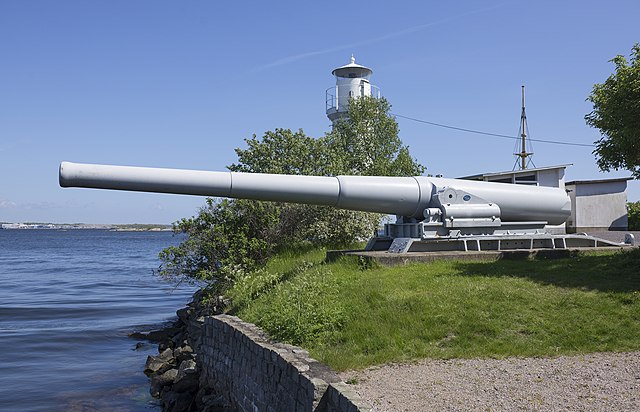
The main armament of the Oden class was essentially the same as the Svea class, keeping the same 25.4 cm guns and lowring the price of ammunition due to mass production. Only the arrangement changed. The dual mount turret indeed showed its angles were limited to 30° due to the superstructure and the risk that of a single lucjy hit disabling both. Two single turrets were thus devised to house them fore and aft. This made the ships longer as the result. The cebtral superstructure was arranged in a way the guns could fire in almost all directions together, with the greatest arc possible. The two turrets also enabed to fire on two targets simultaneously.
The forward turret indeed had a 272° traverse, the aft one 298°. They were electrically traversed.
To facilitate aiming and ease ammunition loading the ships were very well balanced with a center of gravity calculated on a vertical line through the center of pivot. The ships were lauded as very effective artillery platforms, with little roll even in a broadside.
The guns were heavy and a bit complex to provided by Bofors at first, and instead were ordered to Société Anonyme des Forges et Chantiers de la Méditerranée (FCM) for the guns on Oden and Thor. Bofors-Gullspång however maintained it could be able to create such ordnance and initially received little attention, but ultimately secured financial help from the Riksdag led to a provision of steel blocks purchased from Great Britain, for a manufacture in Sweden. Oden’s main guns were indeed delivered by FCM, designated m/1894A, FCM m/1894B for Niord, Bofors m/1894C for Thor.
Unfortunately, not data for these guns.
Secondary: Bofors 120mm/43 K/45 M1894
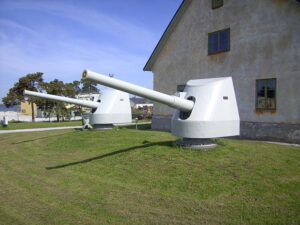
The choice of secondary artillery came from the First Sino-Japanese War in 1894, illustrating the need for armor protection of exposed medium guns. The increase in weight which went with it however forced a lower caliber than the 15 cm initially planned, down to 12 cm. They were ordered to Bofors under the m/1894.
Their breech-loading mechanism was developed by artillery designer Arent Silfversparre for quicker rate of fire. They had a reviewed mounting for separated pointnh in treverse and vartically, and had good muzzle velocity and long range of around 8,000 meters. The caliber reduction was compensated also by a higher rate of fire, at 8-10 shots per minute versus 3 rpm for the 15 cm. It was even tested on drills and ideal conditions up to 12 rounds per minute, earning this new ordnance the title of “rapid-firing”. They were placed in an armored casemate amidships, two pieces on each side. Since Niord and Thor had a lighter Harvey armor six 12 cm guns could be adopted instead of four.
Light Guns: 57 mm
Torpedo boats were considered in 1895 even a more serious threat to large armored ships and since torpedoes were still short range, a surprise close-in attack was feared, and needed to be defeated by rapid fire at close range. The rapidly closing gap meant the main and secondary armament on these ships was completely useless and a large number of light guns and machine guns were preferred to deal with them, in that occurence a mix of four rapid-firing 57 mm guns m/1889B (Odin) placed within the superstructure armored casemate, ten on the two sisters, six were set up in the superstructure, two in the forward and aft bridges.
These Odin’s 57mm/26 K/30 M/1895 guns had a maximum range of 5,000 meters, firing a 2,722 kg shell with a muzzle velocity of 705 meters per second and 35 rounds per minute.
Oden had six 47/49 K/52 M/1895 gun in complement with the same arrangement as the 57 mm guns on Thor and Niord.
The unique military mast also had a fighting top, on which were installed two Maxim-Nordenfelt 8 mm machine guns m/1895.
The two steam sloops carried a 25 mm machine gun m/1884 as well for landing parties.
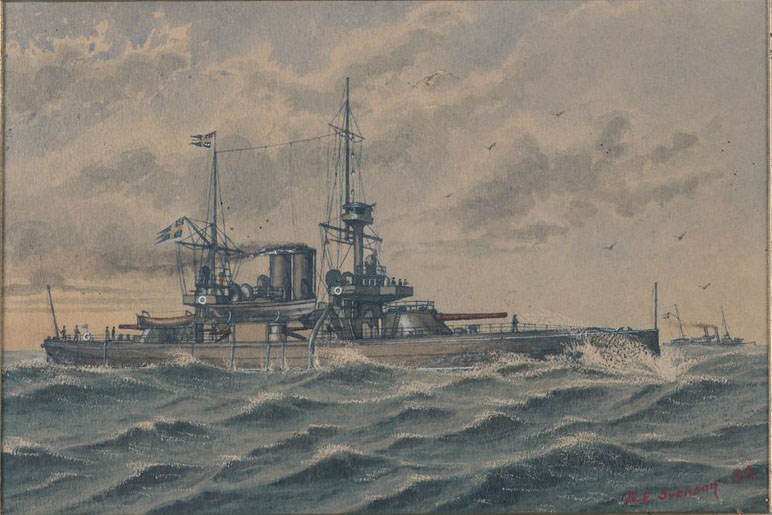
Torpedo Tube
All Oden class ships had a unique 18-inch underwater torpedo tube mounted in the bow, close under the frame. It’s unknown how many spare torpedoes they carried, nor the type. Given the caliber it was presumably a Whitehead model.
Note: For the ship’s names, it was “Hans/Hennes Majestäts Skepp” abbreaviated as HSwMS for surface or submarine vessels. Abroad, the HSwMS is used to avoid the confusion with HMS (British Royal Navy) ships.
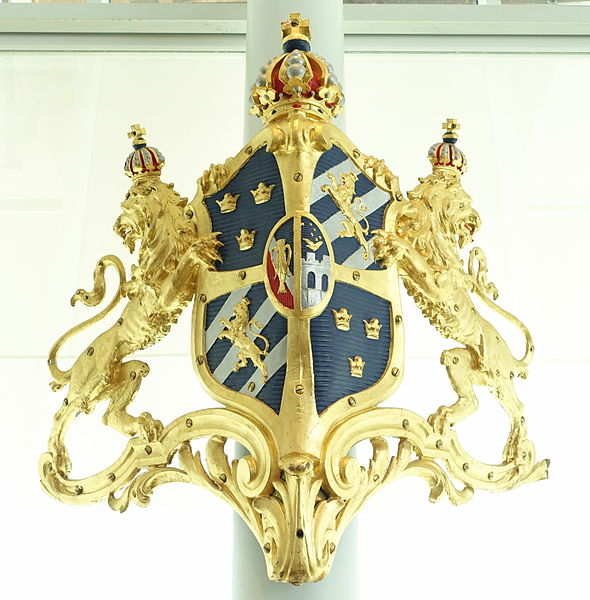
Thor in 1898, preserved sternpost Ornament at the Karlskrona Museum
⚙ specifications |
|
| Displacement | 3,445 tons |
| Dimensions | 84.8 x 14.78 x 5.28m (278 ft 3 in x 48 ft 6 in x 17 ft 4 in) |
| Propulsion | 2 shafts; 2 TE steam engines, 6 boilers: 5,350 ihp (3,990 kW) |
| Speed | 16.5 knots (30.6 km/h; 19.0 mph) |
| Range | coal 300t: 2000nm/10 kts |
| Armament | 2× 25.4 cm, 6× 12 cm, 10× 5.7 cm guns, 1× 45 cm torpedo tube |
| Protection | 24.3 cm (9.6 in) belt, 20 cm (7.9 in) turret |
| Crew | 252 |
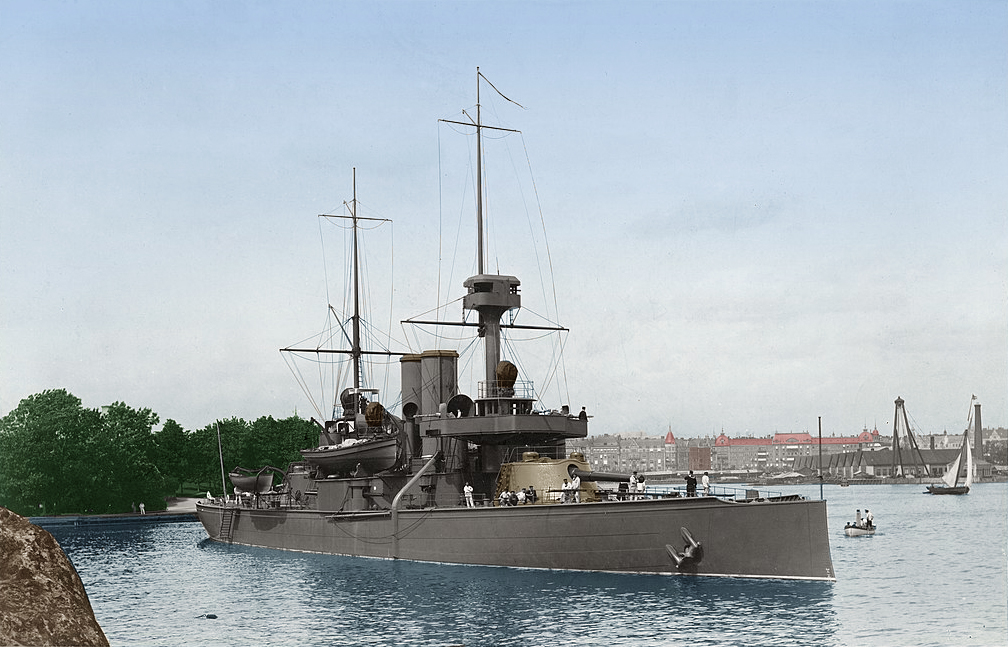
Modernization
-In September 1901, Oden was grounded and seriously damaged. So by doing the repair work, changes were made, with two aft 57mm guns removed from the casemate, relocated onto the superstructure. In their place, two more 12 cm guns were installed to have the same complement as her sisters.
-In 1902 Thor and Niord received counter keels to counteract rolling.
At the outbreak of the First World War the staff though they needed an extensive modernization. So they were taken in hands by 1914-17, at the Karlskrona shipyard for this. Odin was first, followed by her sisters Thor and Niord, which was last. The bridge was moved slightly aft to clear the conning tower, the heavy military mast was replaced by lighter tripod, with a spotting top, light mast and signal mast. The aft mast was shortened and new boilers installed truncated into a single funnel. Top speed increased slightly. The bow torpedo tube was removed and remaining 57 mm guns were moved up onto the superstructure.
 HSwMS Oden
HSwMS Oden
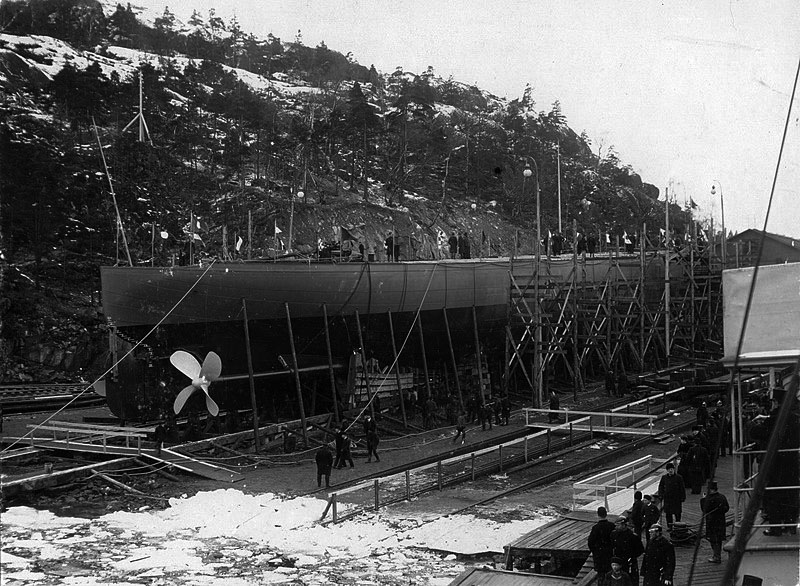
Launch of Odin at Finnboda March, 9, 1896
Oden was built at Finnboda shipyard in Nacka, launched March 9, 1896, trialled by May 25, but before completion, it was decided that she would be sent for the general art and industrial exhibition held in Stockholm this summer of 1897. By order 15 March 1897, there was also the torpedo cruiser Örnen and armored gunboat Folke, latter exchanged for the torpedo boat Galdr. She resumed completion and commissioned by June, 8. No record for her details activities (same for her sisters).
On August 22, 1913, she collided with the gunboat Urd, off Ven’s lighthouse while practicing torpedo firing. The gunboat was its target ship, at short range. The commander was in the conning tower seeing via two narrow slits. He misjudged the distance between the ships until the division commander on the bridge, havijng a far better view saw the danger and ordered a full speed reverse, but this was not communicated to the captain. The collision was severe enough for her ram to cut deep into HMS Urd’s hull, ans she in 23 minutes. The entire was saved, but Court of Appeal later sentenced the captain to a disciplinary penalty of 20 days in custody.
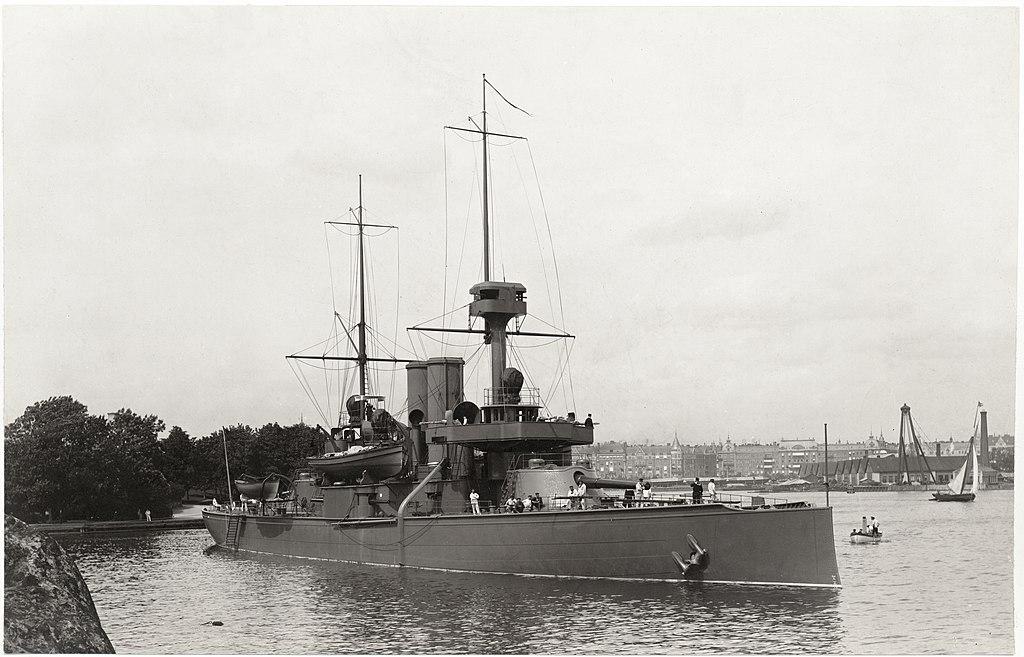
Odin as completed
In September 1901, Oden was grounded and when repaired, she was altered, having new and relocated guns.
As the First World War commenced, she was the first taken in hand for an extensive modernization until 1917, at Karlskrona shipyard. During the war, like her sisters, she made about a year and half of dull neutrality patrols. Post-war it was clear she was completely obsolete.
She was to be converted as an aviation depot ship, but this was dropped and instead, a more modern vessel was chosen for it and she was eventually decommissioned on July 16, 1937. Laid up at the Karlskrona shipyard she was eventually sold for scrapping in 1941, to the shipyard, starting in 1943.
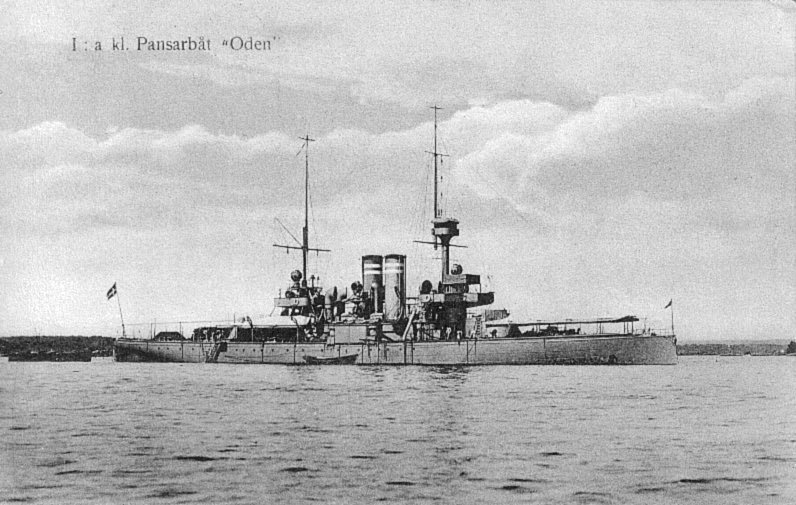
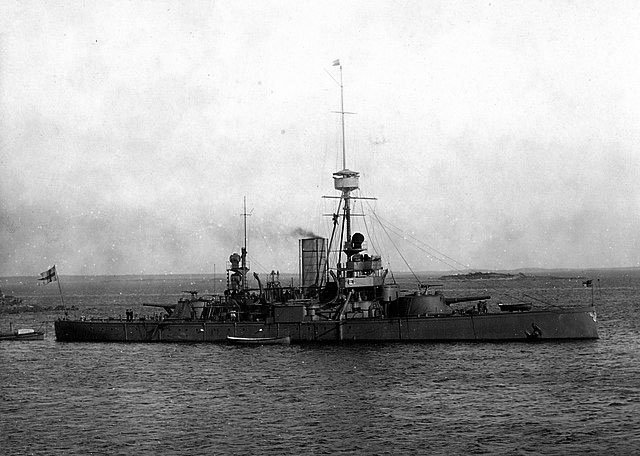
HMS Oden as modenrized
 HSwMS Niord
HSwMS Niord

Lindholmen’s Mekaniska Verkstad, Gothenburg received SEK 1,870,600 to lay down Niord’s keel in 1898. She was launched on 30 March 1899, outfitted and completed on 23 February, commissioned, also in 1899. She was gradually modernized. In 1902 she received counter keels, two 37 mm guns m/1898B were installed on her steam sloops and in 1908 her machine guns were removed, but she had new boilers anbd a new tripod mast, among others in her major WWI refit, at the Karlskrona shipyard until 1917. Like her sister she was astrained to boring neutrality patrols until 1918.
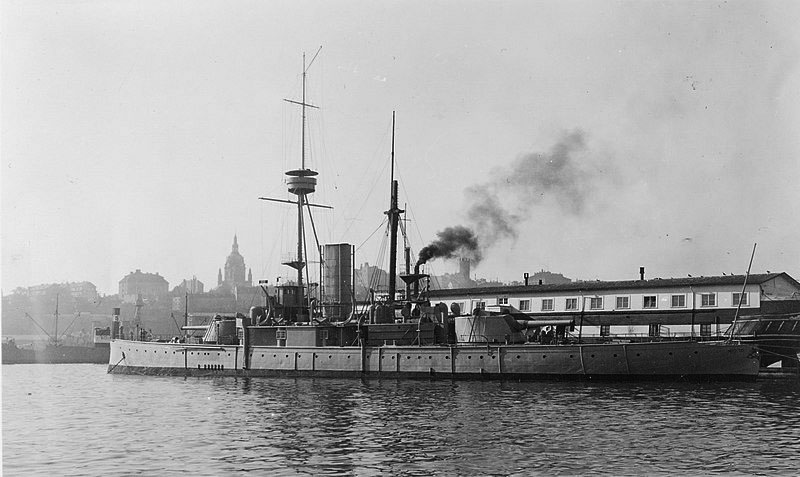
Niord in 1937
In 1921 she was considered too obsolete to have any combat value. On July 7, 1922, she was transformed as an accommodation ship in Karlskrona, replacing the old liner Stockholm. She was moved to Hägersnäs naval air station and later to Stockholm. But detached also to the Firing school at Hårsfjärden. In 1931, under severe unemployment, she was placed at the disposal of the city of Stockholm transformed as residence and training facility for unemployed sailors. In 1935, she replaced the corvette Norrköping as accommodation ship for the corps in Marstrand until closed down. She was towed back to Stockholm, moored at Märsgarn with only two 25 cm guns as armament. After the war broke out in September 1939, she had four 40 mm Bofors m/1922 anti-aircraft guns installed to defend the city and port.
In 1944, Sweden needed treated steel for its new construction program, and she was formally decommissioned in 1944, used as target ship for aircraft, but also tested mines under Commander Henning Muhl. Badly damaged, she was scrapped at Karlskrona shipyard but her aft 25 cm gun was donated to the coastal artillery as reserve in battery Slite, Gotland, now on display at Karlskrona.
 HSwMS Thor
HSwMS Thor
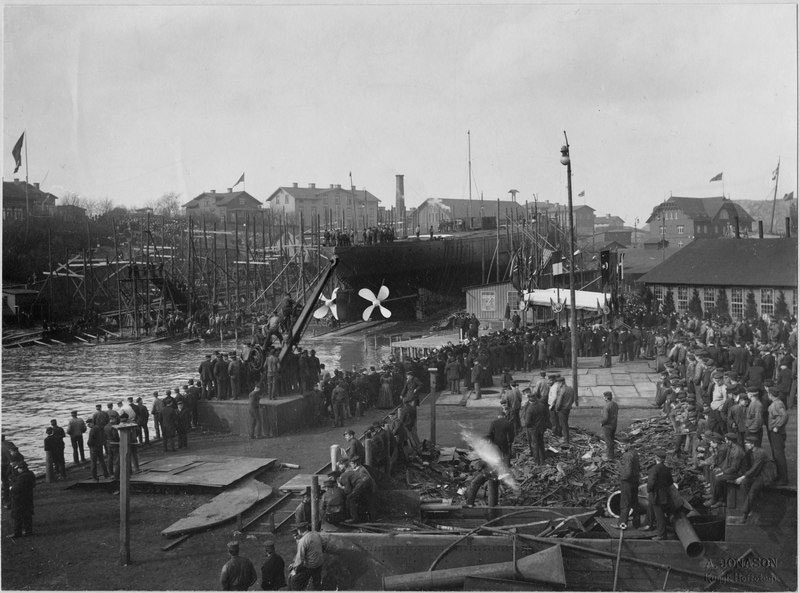
The launch of HMS Thor
Thor was laid down keel in 1897 at Bergsund’s Mekaniska Verkstad, Stockholm, launched on 7 March 1898, completed on 29 June 1899 and commissioned. No record of early life.
During the first decade she underwent some minor refits. In 1902, her hull received counter keels, and in 1906 two quick-firing 37 mm guns m/1898B were added on her steam sloops. In 1908 two of her 8 mm machine guns were removed as a tripod mast was fitted instead of her fighting top military mast.
By the fall of 1914, the fleet was mobilized to enforce Swedish neutrality and it was decided to lead a major modernization on her like her sisters. She spent her wartime years in neutrality sorties along the archipelago and territorial waters.
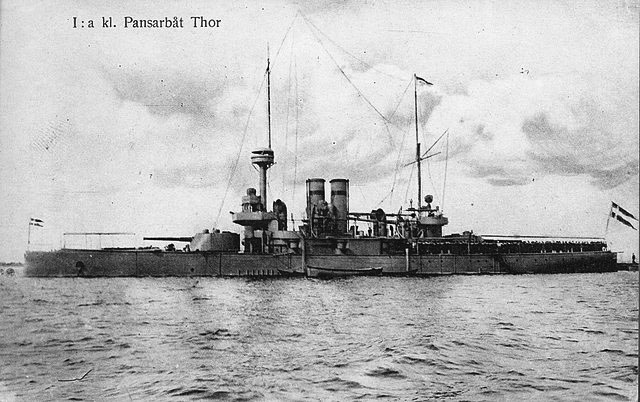
Thor in 1898
In February 1918, Thor took part in the Åland Expedition together with HMS Sverige. On July 16, 1937, she was finally decommissioned, lay for a few years at the at the shipyard in Karlskrona, waiting to be sold for scrap. No tenders were accepted, so it’s the shipyard that decided to scrap her in 1942, gathering much needed steel for a new naval plan.
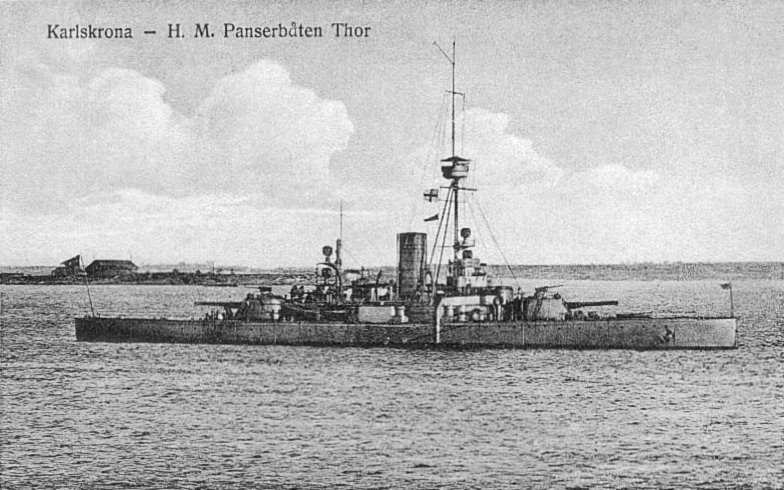
HMS Thor as after refit
Read More/Src
Books
Dodson, Adrian (2016) (på engelska). The Kaiser’s battlefleet. Barnsley: Seaforth Publishing.
Centerwall, Anders Fredrik (1897). ”Årsberättelse i artilleri”. Sjöväsendet (Kungliga örlogsmannasällskapet)
von Hofsten, Gustaf; Waernberg, Jan (2003). Örlogsfartyg: Svenska maskindrivna fartyg under tretungad flagg (1). Svenskt Militärhistoriskt Bibliotek
Insulander, Per; Olhsson, Curt S (2001). Pansarskepp: Från John Ericsson till Gustav V. Falkenberg: C B Marinlitteratur.
Westerlund, Karl-Erik (1992). Svenska örlogsfartyg 1855-1905. Karlskrona.
Westrin, Theodor, red (1914). ”Pansarfartyg”. Nordisk familjebok “Uggleupplagan”: Volym 20 -Norrsken – Paprocki. Nordisk familjeboks
Campbell, N. J. M. (1979). “Sweden”. In Chesneau, Roger & Kolesnik, Eugene M. (eds.). Conway’s All the World’s Fighting Ships 1860–1905. Greenwich: Conway Maritime Press.
Insulander, Per (2001). Pansarskepp: Från John Ericsson til Gustaf V. Falkenberg: C B Marinlitteratur.
Westerlund, Karl-Erik (1992). Svenska örlogsfartyg 1855-1905. Karlskrona: Marinlitteraturföreningen.
Von Hofsten, Gustaf; Waernberg, Jan (2003). Örlogsfartyg: Svenska maskindrivna fartyg under tretungad flagg.
Links
https://runeberg.org/nfbt/0764.html
https://web.archive.org/web/20230406143226/http://www.navypedia.org/ships/sweden/sw_bb_oden.htm
https://web.archive.org/web/20210505093924/navalhistory.flixco.info/H/285304×53056/8330/a0.htm
https://sv.wikipedia.org/wiki/Oden-klass

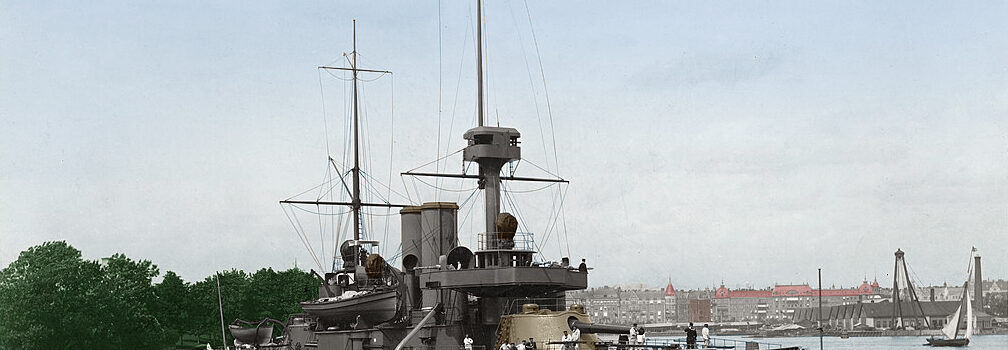
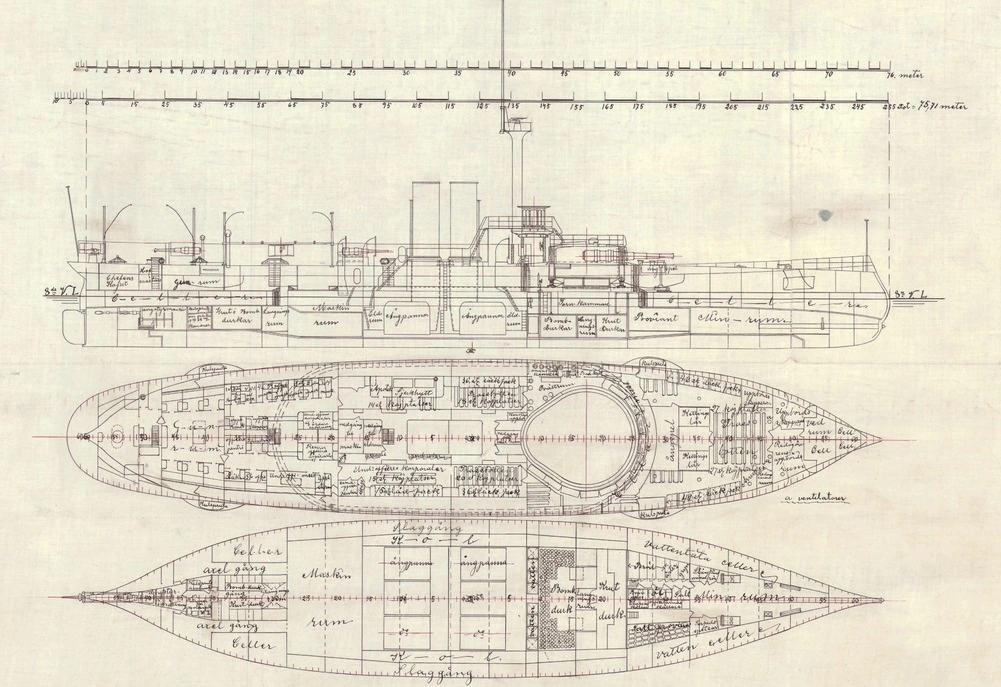
 Latest Facebook Entry -
Latest Facebook Entry -  X(Tweeter) Naval Encyclopedia's deck archive
X(Tweeter) Naval Encyclopedia's deck archive Instagram (@navalencyc)
Instagram (@navalencyc)





 French Navy
French Navy Royal Navy
Royal Navy Russian Navy
Russian Navy Armada Espanola
Armada Espanola Austrian Navy
Austrian Navy K.u.K. Kriegsmarine
K.u.K. Kriegsmarine Dansk Marine
Dansk Marine Nautiko Hellenon
Nautiko Hellenon Koninklije Marine 1870
Koninklije Marine 1870 Marinha do Brasil
Marinha do Brasil Osmanlı Donanması
Osmanlı Donanması Marina Do Peru
Marina Do Peru Marinha do Portugal
Marinha do Portugal Regia Marina 1870
Regia Marina 1870 Nihhon Kaigun 1870
Nihhon Kaigun 1870 Preußische Marine 1870
Preußische Marine 1870 Russkiy Flot 1870
Russkiy Flot 1870 Svenska marinen
Svenska marinen Søværnet
Søværnet Union Navy
Union Navy Confederate Navy
Confederate Navy Armada de Argentina
Armada de Argentina Imperial Chinese Navy
Imperial Chinese Navy Marinha do Portugal
Marinha do Portugal Mexico
Mexico Kaiserliche Marine
Kaiserliche Marine 1898 US Navy
1898 US Navy Sovietskiy Flot
Sovietskiy Flot Royal Canadian Navy
Royal Canadian Navy Royal Australian Navy
Royal Australian Navy RNZN Fleet
RNZN Fleet Chinese Navy 1937
Chinese Navy 1937 Kriegsmarine
Kriegsmarine Chilean Navy
Chilean Navy Danish Navy
Danish Navy Finnish Navy
Finnish Navy Hellenic Navy
Hellenic Navy Polish Navy
Polish Navy Romanian Navy
Romanian Navy Turkish Navy
Turkish Navy Royal Yugoslav Navy
Royal Yugoslav Navy Royal Thai Navy
Royal Thai Navy Minor Navies
Minor Navies Albania
Albania Austria
Austria Belgium
Belgium Columbia
Columbia Costa Rica
Costa Rica Cuba
Cuba Czechoslovakia
Czechoslovakia Dominican Republic
Dominican Republic Haiti
Haiti Hungary
Hungary Honduras
Honduras Estonia
Estonia Iceland
Iceland Eire
Eire Equador
Equador Iran
Iran Iraq
Iraq Latvia
Latvia Liberia
Liberia Lithuania
Lithuania Mandchukuo
Mandchukuo Morocco
Morocco Nicaragua
Nicaragua Persia
Persia San Salvador
San Salvador Sarawak
Sarawak Uruguay
Uruguay Venezuela
Venezuela Zanzibar
Zanzibar Warsaw Pact Navies
Warsaw Pact Navies Bulgaria
Bulgaria Hungary
Hungary

 Bundesmarine
Bundesmarine Dutch Navy
Dutch Navy Hellenic Navy
Hellenic Navy Marina Militare
Marina Militare Yugoslav Navy
Yugoslav Navy Chinese Navy
Chinese Navy Indian Navy
Indian Navy Indonesian Navy
Indonesian Navy JMSDF
JMSDF North Korean Navy
North Korean Navy Pakistani Navy
Pakistani Navy Philippines Navy
Philippines Navy ROKN
ROKN Rep. of Singapore Navy
Rep. of Singapore Navy Taiwanese Navy
Taiwanese Navy IDF Navy
IDF Navy Saudi Navy
Saudi Navy Royal New Zealand Navy
Royal New Zealand Navy Egyptian Navy
Egyptian Navy South African Navy
South African Navy






























 Ukrainian Navy
Ukrainian Navy dbodesign
dbodesign